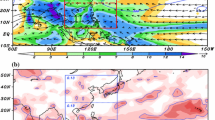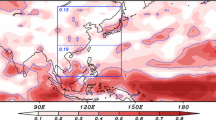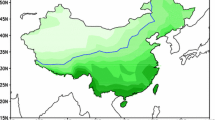Abstract
Century-long efforts have been devoted to seasonal forecast of Indian summer monsoon rainfall (ISMR). Most studies of seasonal forecast so far have focused on predicting the total amount of summer rainfall averaged over the entire India (i.e., all Indian rainfall index-AIRI). However, it is practically more useful to forecast anomalous seasonal rainfall distribution (anomaly pattern) across India. The unknown science question is to what extent the anomalous rainfall pattern is predictable. This study attempted to address this question. Assessment of the 46-year (1960–2005) hindcast made by the five state-of-the-art ENSEMBLE coupled dynamic models’ multi-model ensemble (MME) prediction reveals that the temporal correlation coefficient (TCC) skill for prediction of AIRI is 0.43, while the area averaged TCC skill for prediction of anomalous rainfall pattern is only 0.16. The present study aims to estimate the predictability of ISMR on regional scales by using Predictable Mode Analysis method and to develop a set of physics-based empirical (P–E) models for prediction of ISMR anomaly pattern. We show that the first three observed empirical orthogonal function (EOF) patterns of the ISMR have their distinct dynamical origins rooted in an eastern Pacific-type La Nina, a central Pacific-type La Nina, and a cooling center near dateline, respectively. These equatorial Pacific sea surface temperature anomalies, while located in different longitudes, can all set up a specific teleconnection pattern that affects Indian monsoon and results in different rainfall EOF patterns. Furthermore, the dynamical models’ skill for predicting ISMR distribution primarily comes primarily from these three modes. Therefore, these modes can be regarded as potentially predictable modes. If these modes are perfectly predicted, about 51 % of the total observed variability is potentially predictable. Based on understanding the lead–lag relationships between the lower boundary anomalies and the predictable modes, a set of P–E models is established to predict the principal component of each predictable mode, so that the ISMR anomaly pattern can be predicted by using the sum of the predictable modes. Three validation schemes are used to assess the performance of the P–E models’ hindcast and independent forecast. The validated TCC skills of the P–E model here are more than doubled that of dynamical models’ MME hindcast, suggesting a large room for improvement of the current dynamical prediction. The methodology proposed here can be applied to a wide range of climate prediction and predictability studies. The limitation and future improvement are also discussed.










Similar content being viewed by others
References
Blockeel H, Struyf J (2003) Efficient algorithms for decision tree cross-validation. J Mach Learn Res 3:621–650
DelSole T, Shukla J (2009) Artificial skill due to predictor screening. J Clim 22:331–345
Gadgil S, Gadgil S (2006) The Indian monsoon, GDP and agriculture. Economic Political Weekly, Mumbai
Gadgil S, Sajani S (1998) Monsoon precipitation in the AMIP runs. Clim Dyn 14:659–689
Gadgil S, Srinivasan J (2011) Seasonal prediction of the Indian monsoon. Curr Sci 100:343–353
Gadgil S et al (2004) Extremes of the Indian summer monsoon rainfall, ENSO and equatorial Indian Ocean oscillation. Geophys Res Lett 31:L12213
Gadgil S, Rajeevan M, Nanjundiah R (2005) Monsoon prediction—Why yet another failure? Curr Sci 88:1389–1400
Geisser S (1975) The predictive sample reuse method with applications. J Am Stat Assoc 70:320–328
Gill AE (1980) Some simple solutions for heat-induced tropical circulation. Q J Roy Meteor Soc 106:447–462
Gowariker V et al (1991) A power regression model for long range forecast of southwest monsoon rainfall over India. Mausam 42:125
Guhathakurta P, Rajeevan M, Thapliyal V (1999) Long range forecasting Indian summer monsoon rainfallby a hybrid principal component neural network model. Meteorol Atmos Phys 71:255–266
Kalnay E et al (1996) The NCEP/NCAR 40-year reanalysis project. B Am Meteorol Soc 77:437–471
Kang IS et al (2002) Intercomparison of the climatological variations of Asian summer monsoon precipitation simulated by 10 GCMs. Clim Dyn 19:383–395
Kumar KK, Soman MK, Kumar KR (1995) Seasonal forecasting of Indian summer monsoon rainfall: a review. Weather 50:449–467
Kumar KK et al (2006) Unraveling the mystery of Indian monsoon failure during El Niño. Science 314:115–119
Lee J-Y et al (2011) How predictable is the northern hemisphere summer upper-tropospheric circulation? Clim Dyn 37:1189–1203
Lee J-Y et al (2013) Seasonal prediction and predictability of the Asian winter temperature variability. Clim Dyn 41:573–587
Mishra V et al (2012) A prominent pattern of year-to-year variability in Indian Summer Monsoon Rainfall. Proc Natl Acad Sci 109:7213–7217
North GR et al (1982) Sampling errors in the estimation of empirical orthogonal functions. Mon Weather Rev 110:699–706
Rajeevan M (2001) Prediction of Indian summer monsoon: status, problems and prospects. Curr Sci 81:101–107
Rajeevan M et al (2006) High resolution daily gridded rainfall data for the Indian region: analysis of break and active monsoon spells. Curr Sci 91:296–306
Rajeevan M et al (2007) New statistical models for long-range forecasting of southwest monsoon rainfall over India. Clim Dyn 28:813–828
Rajeevan M, Bhate J, Jaswal AK (2008) Analysis of variability and trends of extreme rainfall events over India using 104 years of gridded daily rainfall data. Geophys Res Lett 35:L18707
Rajeevan M, Unnikrishnan CK, Pai DS (2012) Long range forecasting of the Indian summer monsoon. Indian Institute of Tropical Meteorology, Pune
Shukla J, Mooley DA (1987) Empirical prediction of the summer monsoon rainfall over India. Mon Weather Rev 115:695–704
Sinha P et al (2013) Seasonal prediction of the Indian summer monsoon rainfall using canonical correlation analysis of the NCMRWF global model products. Int J Climatol 33:1601–1614
Sinha P et al (2014) Role of the himalayan orography in simulation of the Indian summer monsoon using RegCM3. Pure Appl Geophys 171:1385–1407
Smith TM et al (2008) Improvements to NOAA’s historical merged land-ocean surface temperature analysis (1880–2006). J Clim 21:2283–2296
Smith TM et al (2010) Merged statistical analyses of historical monthly precipitation anomalies beginning 1900. J Clim 23:5755–5770
Wang B, Wu R, Li T (2003) Atmosphere-warm ocean interaction and its impacts on Asian–Australian monsoon variation. J Clim 16:1195–1211
Wang B et al (2005) Fundamental challenge in simulation and prediction of summer monsoon rainfall. Geophys Res Lett 32:L15711
Wang B et al (2007) Coupled predictability of seasonal tropical precipitation. CLIVAR Exch 12:17–18
Wang B et al (2013) Northern Hemisphere summer monsoon intensified by mega-El Niño/southern oscillation and Atlantic multidecadal oscillation. Proc Natl Acad Sci 110:5347–5352
Wang B, Lee JY, Xiang B (2015a) Asian summer monsoon rainfall predictability: a predictable mode analysis. Clim Dyn 44:61–74
Wang B et al (2015b) Rethinking Indian monsoon rainfall prediction in the context of the recent global warming. Nat Commun 6. doi:10.1038/ncomms8154
Webster PJ, Hoyos CD (2010) Beyond the spring barrier? Nat Geosci 3:152–153
Weisheimer A et al (2009) ENSEMBLES: a new multi-model ensemble for seasonal-to-annual predictions: skill and progress beyond DEMETER in forecasting tropical Pacific SSTs. Geophys Res Lett 36:L21711
Xing W, Wang B, Yim S-Y (2014) Peak-summer East Asian rainfall predictability and prediction part I: Southeast Asia. Clim Dyn. doi:10.1007/s00382-014-2385-0
Acknowledgments
This work was jointly supported by NOAA/MAPP Project Award Number NA10OAR4310247, the US National Science Foundation awards #AGS-1005599, the National Research Foundation (NRF) of Korea through a Global Research Laboratory grant (MEST, #2011-0021927) and the APEC Climate Center. We also acknowledge support from the US-China Atmosphere–Ocean Research Center sponsored by Nanjing University of Information Science and Technology (NUIST). This is publication No.9451 of the School of Ocean and Earth Science and Technology, the publication No.1129 of the International Pacific Research Center and the publication No.55 of NUIST Earth System Modelling Center.
Author information
Authors and Affiliations
Corresponding author
Rights and permissions
About this article
Cite this article
Li, J., Wang, B. How predictable is the anomaly pattern of the Indian summer rainfall?. Clim Dyn 46, 2847–2861 (2016). https://doi.org/10.1007/s00382-015-2735-6
Received:
Accepted:
Published:
Issue Date:
DOI: https://doi.org/10.1007/s00382-015-2735-6




